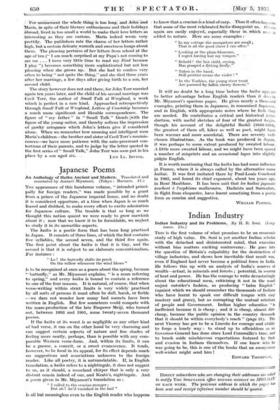Japanese Poems
An Anthology of Haiku Ancient and Modern. Translated and annotated by Asataro Miyamori. (Tokyo : Maruzen.
•
TILE appearance of this handsome volume, " intended princi- pally for foreign readers," was made possible by a grant from a prince of the Japanese imperial house, and no doubt it is considered opportune, at a time when Japan is so much reared and disliked, to make every effort to excite admiration for Japanese culture. The trouble is that so long as we thought this nation quaint we were ready to grow mawkish about it ; now that we know it to be formidable, we neglect to study it in its unwarlike aspects.
The haiku is a poetic form that has, been long practised
in Japan. It consists of three lines, of which the first contains
five syllables, the second seven, and the third five again. The first point about the haiku is that it is tiny, and the second is that it is subject to an elaborate conventionalism.
For instance : " Lo ! the butterfly shifts its perch On the willow whenever the wind blows " 1s to be recognized at once as a. poem about the spring, because
butterfly," as Mr. Miyamori explains, " is a noun referring to spring," and every haiku is bdund to contain a reference to one of the four seasons. It is natural, of course, that when verse-writing within strict limits is very widely practised
by all sorts of persons it must often be dull, harsh, or feeble —we dare not wonder how many bad sonnets have been written in English. But few sonneteers could compete with the mass-production of the late' Emperor-Meiji, who -turned out, between 1893 and 1901, some twenty-seven thousand poems.
If the haiku at its worst is as negligible as any other kind
of bad verse, it can on the other hand be very charming and can suggest certain aspects of nature and fine shades of feeling more neatly, perhaps, than is possible with any com- parable Western verse-form. And, within its limits, it can be a gnome, a conceit, or a sweet evanescence. It tends, however, to be local in its appeal, for its effect depends much on suggestions and associations unknown to the foreign
reader. Like all poetry, it is untranslatable. If, in English translation, a haiku refers to a nightingale, it does not suggest to us, as it should, a moorland chirper that is only a very distant cousin indeed of our, and Keats's, nightingale. And a poem given in Mr. Miyamori's translation as :
" I called to the crucian-monger ; But ah f he'd vanished in the hail "
is all but meaningless even to the English reader who happens to know that a crucial-pis-a kind of carp. Thus it often happens that some of the most celebrated .haiku disappoint us. 01 'nem again. are easily enjoyed, especially those in which man is added to nature. Here are some examples :
" In my cottage the mosquitoes are small ; That is all the good cheer I can offer."
" Looking at the plum-blossoms, I regret having-lost my temper."
" Behold ! the lost child, crying, Has grasped a flitting 'firefly. '
" Taken in the hand, Still prettier seems the violet ! "
" In the Yoshino, the young river trout Are pursuectby YfaEen cherry flowers."
It will no doubt be a long 'time before the haiku appears to better advantage before Knglish readers than it does in Mr. Miyamori's spacious pages. He gives nearly a thousand examples, printing them in' JaPanese, in romanized Japanese, and in English, with appropriate notes where he feels they are needed. He contributes a critical and historical intro- duction, with useful sketches of four of the greatest haijin, though his account of the delightful Bash5 (1644-1694), the greatest of them all, hiker as well as poet, might have been warmer and more anecdotal. There are seventy well- chosen illustrations. As the book was produced in Japan, it was perhaps to' some extent 'produced by sweated labour. A little more sweated labour, and we might have been spared a number of misprints and an occasional lapse into slightly pidgin English.
It is worth mentioning that the haiku has had some influence in France, where it is always called by the alternative name haikai. It was first imitated there by Paul-Louis Couchoud in 1905, and found its chief exponent, about ten years ago, in Rene Maublanc. It has been said that les haikai japonais touchent a l'orphisme mallarmien. Dadaists and Surrealists, in illght_from -eloquelfee, have learnt something from a poetic form so concise and suggestive.
WILLIAM PLONIER.










































 Previous page
Previous page